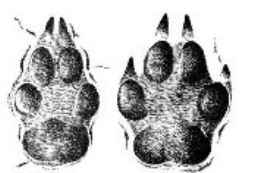Use of material is possible with active link
© 2015 - 2024. Hunting, Fishing - Information Portal Support the project, donate
The wolf ordinary
Wolves are protected in Spain, Poland , Romania , Greece , Portugal , Slovakia , Crete , partially protected in the Baltic States , Serbia , Macedonia , Bulgaria , Bosnia. In Poland, the wolf is listed as endangered . The wolf is listed in the European Red list, is protected by the Berne Convention.
The wolf ordinary.
Wolves - description, lifestyle behaviors. Below, links to other interesting articles about wolves. Wolves video.
In the zone of tundra seats are very large wolves weighing up to 60 kg, different light (whitish) soft and lush winter fur. In the Siberian taiga are wolves large size with less lush and soft winter fur gray. Large wolves of the European part are fur more rigid and not as lush (especially wolves of the steppe region), a noticeable admixture of reddish hues. Medium-size wolves Kazakhstan have grey or reddish fur, in the deserts of Central Asia minor wolves - yellowish sandy fur. In the Caucasus the fur of the wolves dirty-brown. Fade wolves twice a year. In the spring, usually April - June, autumn September - November.
Wolves are common almost everywhere, except on the Islands of the Arctic ocean, where the wolves are occasionally run on ice. Especially a lot of wolves in the steppe and forest-steppe areas, where the most developed animal husbandry. The taiga wolves little and stay mainly in river valleys. In the tundra wolves live near herds of reindeer.
Wolves arrange in some lonely place in the forest zone in the forest, thicket, ravines, on Islands in the marshes; in the steppes along the beams, among the reeds near the lakes, the forests. In the steppe areas and tundra wolves often live in the summer in burrows. The lair is always near water. In the autumn of seasoned wolves together with young (young offspring of the current year), and sometimes with pereyarki (born last year) wander on different grounds, looking for food. Nomadic lifestyle wolves are all winter. On the day deposited in the forest Islands, reed beds, shrubberies, among the rocks.
Mating occurs in the Central regions occurs in February in the South in January. After 62-63-day pregnancy wolf brings from 5 to 12 blind, covered with a low, soft brownish fur babies. The cubs suck mother for about 1 month, also eat half-digested flesh, which they regurgitate parents. Later, the wolf and the wolf bring to TESDA different animals. The maturity of wolves comes in 2-years of age.
In the summer of the wolves hunt for various wild animals and birds and attack Pets. Winter broods often wander about dwellings man in search of carrion and different waste, catch dogs, get into the sheepfold and cattle yards. Wolves could starve, but narrowly missed the food, the average wolf can eat up to 8 kg.
Wolves cause a lot of damage especially in autumn, when they grow broods and go hunting. Destroying a large number of livestock (mostly sheep) and valuable game animals (elk, deer, hares, geese, wolves bring to the national economy huge losses. Rabid wolves are extremely dangerous to humans, but also healthy wolves sometimes attack people. So wolves should destroy all year round by all means. For extracted wolves paid a bonus. Annually produces 35-40 % wolf traps, and a gun on hunting raids with flags. In 1983 and 1984 was prepared to 36.1 thousand skins.
The red wolf is different from the wolf ordinary lower, longer and more lush tail, red fur and rounded ears. Body length 100-110 see is Found in the mountains of Central Asia, Central and Eastern Siberia and the Far East. Keep the red wolves cubs in the mountainous areas where they hunt for mountain goats and sheep. Also eat small rodents and birds. The number is very small. Listed in the Red books of IUCN and the Russia, hunting is prohibited.
Wolves are not described in a small number of documentary and artistic works. Attitudes toward wolves varies in different periods of time in different countries.
Wolf. Tamed wolves. Video:

Traces of the wolf:

Video: Wolf attacks and takes the dog
Video: About wolves. Description and facts of the life of a wolf. Attacks on other animals, wolf hunting.
